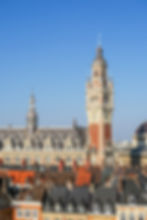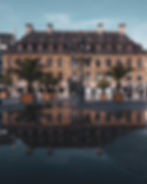What to visit in Lille?
- Diogo Machado
- Mar 14, 2022
- 7 min read
Updated: May 31, 2022
In the North of France on the border with Belgium, the city of Lille stands warmly preserving many treasures of French Flanders. The capital of the Nord-Pas de Calais region proudly maintains its diversity due to the multiple influences it had before becoming French (Flemish, Burgundian, then Spanish). Interestingly, its name comes from the word 'island' (Île in French), as it was originally located on an island in the middle of the River Deûle. A labyrinthine medieval quarter, many characteristic estaminets (traditional northern cafés), Medieval and Renaissance buildings, and spots of Art Nouveau, will be what stick in your mind, during your visit to the Vieux Lille.
Lille is the ideal city for long walks, so grab your most comfortable shoes and let's go parrots!
Discover with us:
🎫 Events
__________________________________________________________________________________
What not to miss?
A mercantile and industrial city in the 19th and 20th centuries, Lille encloses an atmosphere of enchanting places. Our recommendations are as follows:
Le palais des Beaux-Arts
Lille's Palais des Beaux-Arts is France's second-largest museum after the Louvre. It has been called "the jewel of Lille" by some, and while it hasn't yet reached the dizzying heights of popularity that the Louvre enjoys, it is a truly remarkable place to visit. The museum itself is a summer palace from the end of the 19th century, and you may need as long as half a day to get the most out of the museum. It's worth taking a moment to enjoy the exterior of this lovely building before you go in. The building itself was completed at the end of the 19th century, and its interior details are just as impressive as its facade: marble stairs and columns, intricate decorations on the walls and ceilings, and massive chandeliers. The art collections include paintings made by the most famous European painters from the Middle Ages to modern times.

La Grand’Place
The square is surrounded by buildings of great beauty and Flamish-style architecture. In front, another building houses the Chamber of Commerce, where you can realize the signs with the names of companies that were established in Lille during its golden age. Other important buildings are those that house banks and large hotels. The Grand Square has also been used for celebrations, fairs, festivals, and other events related to trade or popular festivities, such as Carnival or Christmas.
La Citadelle
Built-in 1675, the Citadelle of Lille is one of the most beautiful castles in France. It's the last example of fortress architecture from the 17th century. You can also visit the Museum of Natural History in Lille, which is located in the same building as the Military Museum. The Citadelle was built to protect Lille from enemy invasions, who could be seen coming from miles away thanks to this construction that overlooks the whole city.
What else to visit?
Lille is a city for all tastes since it combines lots of goodies for lovers of art, history, music, and nature. It is so difficult to figure out what things are worth seeing in this city!! Anyway, we will try to make a list to give you the right advice:

Le beffroi de la Grand'Place
La Vieille Bourse is a building with a magnificent facade and many locals believe this is the most beautiful building in the city. It is located in the center of Lille, in the very heart of the Vieux-Lille district, just next to the Opera House. In the old days, La Vieille Bourse was used as a place for commercial meetings between booksellers, jewelers, traders, and merchants from all over Europe.
Hospice Comtesse
Hospice Comtesse is located in the old town of Lille. It is now a museum on the history of the hospice. The collections include ceramics, paintings, and furniture. Moreover, Hospice Comtesse is also known for its beautiful garden, a green space in the core of the city center, which is open to visitors from April to September.
La Piscine - André Diligent Museum of Art and Industry in Roubaix:
Housed in a former public swimming pool dating back to the end of the 19th century, the museum evokes an extraordinary atmosphere created by the water and the Art Nouveau decorations. The collection boasts important examples of applied art, paintings, and objects and has a notable section dedicated to costumes and textiles that were sold in the old town (such as wool in Flanders).
Lille Flea Market
Lille Flea Market is one of the oldest outdoor markets in Europe, dating back to Medieval times. Today, it is considered one of the biggest outdoor markets in Europe. The market is spread out over several streets and squares in the center of Lille and is open only the first weekend of September. The market has a great atmosphere, with a variety of things on sale including antiques, furniture, art, clothing, and more. French people go to the markets as a hobby, so if you want to enjoy the local experience, don't miss visiting Lille Flea Market. You might get a deal!
Native house of Charles de Gaulle
Did you know that Lille was once the home of President De Gaulle? Today it has become a museum that preserves the evidence of the De Gaulle family. Maison Natale Charles de Gaulle, is located in the old town of Lille. The house was built in 1667 by the merchant Jean-Baptiste Lebas and was bought by Charles de Gaulle's grandfather in 1872. This is where the general was born on 22 November 1890. The museum traces his life and career through documents, photographs, and objects. In the courtyard, you can see the statue of a young Charles de Gaulle with a sword, which he received for his first communion.

How to travel there?
The city has a perfect location between 2 capitals – 4 hours from Brussels and just 2 hours from Paris. The city is a great stop-off for tourists coming from the U.K as well. There is an international airport located 10 km from the center of Lill. If you are a train travel lover, there is good news for you. The city of Lille is very well connected with the other main French cities by train. The building of the railway station, Gare Lille-Flandres, is one of the oldest in the city.
Lille is located 222 km north of Paris by car, and it's easily reachable through the toll roads. And if you are coming from Paris, check our article about visiting Paris to make the most of your experience in France and visit these two beautiful cities. The easiest way to reach the city from the U.K is by taking the ferry to Calais Ferry Port which is 111 km away from Lille.
Average costs
Lille is the fourth largest city in France and the cost of leaving is near to average to the other big cities.
Transportation:
The city provides many types of transportation like trams, buses, and the metro. The ticket system is very well organized and T you can buy a bunch of general "transport" tickets and they’ll work for any kind of transportation. A single ticket costs €1.60, or €14 for a pack of ten. You can also get the day (24hrs) or even evening passes which are valid for all transport after 7 pm.
Restaurants:
The city provides many types of restaurants for any taste and budget. A meal in a budget restaurant costs between 8 and 18 euros (for a person). Midrange restaurants provide a menu for 2 for the price between 24 and 55 euros.
Accommodations:
In Lille, you can stay in a hotel or hostel or another Airbnb accommodation. Average prices for the hotels depend on the stars of the hotel. For example, one night in a 3 stars hotel in Lille costs around 76 euros for a double room. The price for a night in a 5 stars hotel can go to 370 euros per night for a double room.
Of course, there are many cheap options like hostels, where the price depends on the season.

When to travel there?
The city is located in the north of France and the best time to visit it is late spring or early summer when the weather is great for street walks during the day and the night. Last year, the city become a popular destination for early fall as well.
What to eat?
The cuisine of Lille is inspired by Flemish culture more than by the French, as the potjeevleesch or the carbonnade flammande dishes suggest. Moreover, it must be said that the favorite local drink is not the wine but actually it's the beer. Here we share with you some recommendations on local places to try:
Aux Moules de Lille: a classic little fish restaurant specializing in mussels cooked nine ways. Other delicious dishes on the menu are Shrimp croquettes and lobster.
One of the best places in the city is Patisserie Méert a pretty pastry shop founded in 1971. It is the most famous one and you're sure to be delighted by the delicacies in their showcases. What you must know is that the specialty of the region is waffles (gaufre lilloise). So, you can't leave without tasting it!
The Sunday market in the neighborhood of Wazemmes, but also Rue des Bouchers are the major places we advise you to go when you are assailed by hunger!
If you're curious about traditional dishes, you can read our article about what to eat and drink in Lille!
Events
In such a vibrant and welcoming city, the perfect visitor cannot avoid attending events. Here is our suggestion for you:
Lille Art Up (March-April)
A contemporary art fair, and of aesthetic issues, took place at Grand Palais where over international galleries take center stage. Each edition focuses on the Lille located 222 km north of Paris by car main theme with a program involving sculpture, painting, drawing, video, photography, and so on.

Braderie de Lille (September)
Preceded by a half marathon, this famous popular manifestation preserves the witness to the rich commercial past of the city. 10,000 exhibitors where dealers and antique enthusiasts meet there to carry on a long tradition. Huge plates of mussels with fried potatoes, the gastronomic symbol of the city, are eaten everywhere.
Lille Street Food Festival (October)
4 days to celebrate the best street food culture. Participants can enjoy delicious food in the festival's multitude of food trucks together with concerts and other entertainment.
Fête de l'Anim (November): Immerse yourself in the heart of animated cinema around numerous screenings, masterclasses, meetings, and previews, in the name of cinema for all types of cinephiles.
Christmas Market (December)
Christmas village brings together numerous chalets with handicrafts from all over the world. Ideally, you should visit while enjoying gingerbread cakes and mulled wine while Christmas carols fill the air.
This was our short guide for Lille. Traveling through the European Capital of Culture, between the charm linked to the contaminations of ancient settlements in the old town and the lively markets and estaminets of the dynamic and young center. Never stop exploring beautiful places and check our other articles, and follow @thewalkingparrot to keep up to date when the article will be published.



